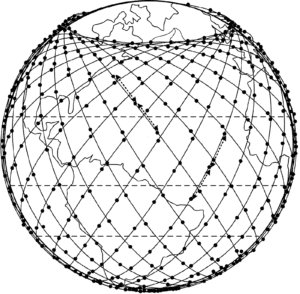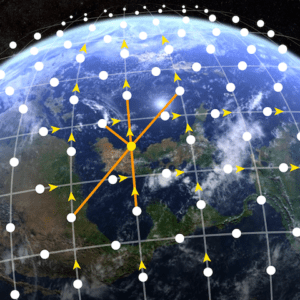
Each satellite will have a data bandwidth of 20 Gbps, which means a combined bandwidth of almost as much as the total Internet traffic today.
At present, internet-providing satellites are usually geostationary satellites, and orbit at an altitude of 35,000 km above us in order to cover a large part of the Earth’s surface. The fact that they maintain the same position relative to the Earth’s surface means they can always be reached by connecting stations.
However, this design prevents high Internet access speeds. It takes 240 ms for a data signal to reach the satellite and return to another ground station – this is 6 times slower than an LTE connection.
Starlink is radically changing this model. SpaceX hopes to launch 11,943 satellites (plus a few spare ones) into Low Earth Orbit (LEO) and into Very Low Earth Orbit (VLEO) by 2027.

SpaceX satellite Internet project status update
Starlink satellites will fly quite low, which reduces the amount of Earth’s surface each satellite can cover. In other words, the area where a ground station must be so a satellite can communicate with it is limited. The coverage area radius for LEO satellites is approximately 1,000 km and it’s about 400 km for VLEO.
The Starlink satellites will not be geostationary satellites. This is because they are a lot closer to Earth and need to be able to move quickly to remain in their orbit. They will revolve around the Earth approximately every 100 minutes.
The aim of Starlink is to reduce latency (the time that data takes to travel) between long distances and to provide coverage to remote areas where installing Internet infrastructure isn’t an option (mountainous and forest areas). To achieve this, it has turned towards laser communication. The base station gets the data and uploads it to the satellite with which it thinks it has the best connection. The satellite then lasers the data to neighboring satellites until it reaches one within reach of the destination base station.
Each satellite can have 5 laser connections:
• One with the satellite ahead (in the same orbital plane) – this is always on.
• One with the satellite behind (in the same orbital plane) – this is always on
• One with the satellite ahead of the next orbital plane – this is always on, but the laser angle must be adjusted as the satellite isn’t always in the same place.
• One with the satellite behind the previous orbital plane – this is always on, but the laser angle must be adjusted as the satellite is not always in the same place.
• One with the satellite that is crossing its path from a different orbital plane – this is on and off. It will connect for short periods of time when another satellite is in range.

Wyliodrin-satellite connections
As you will have gathered from the above, the most important process will be how traffic travels from one place to another. Starlink will be a completely new, very high-capacity network that changes every minute, and with a multitude of factors at play in its connectivity (atmospheric conditions, satellite failures, etc.).
It remains to be seen if this communications technology will end up a reality. SpaceX has already launched the first satellites in the network. If Starlink is completed, it won’t be long before we have high-speed Internet connections from anywhere in the world.
Like SpaceX with Starlink, the Teldat Group is constantly innovating to find new ways to improve communication between people.


























